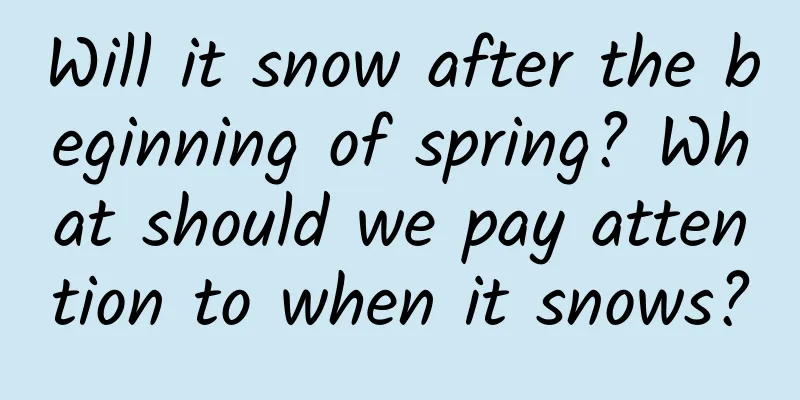Will it snow after the beginning of spring? What should we pay attention to when it snows?

|
Snow has a wide range of uses, but it is very beneficial to humans. Snow can be both beneficial and harmful to humans. In the mid-spring season of March or April, if a sudden cold wave causes heavy snowfall, it will cause freezing. Therefore, the agricultural proverb says: "Winter snow is a treasure, spring snow is not good." Snowflakes are the largest and most complete in shape. Snowflake crystals formed in extremely cold weather are very small, almost invisible to the naked eye. Only when they glitter in the sun can people find them like fine powder. This kind of snow is called dry snow. Contents of this article 1. Will it snow after the beginning of spring? 2. What should you pay attention to when it snows? 3. How many degrees does it usually snow? 1Will it snow after the beginning of spring?The snow after the beginning of spring is also called spring snow. Snow has a wide range of functions, but it is of great benefit to humans. First of all, it is beneficial to the growth and development of crops. Because snow has poor thermal conductivity, a layer of snow covering the soil surface can reduce the outward transfer of soil heat and block the invasion of cold air on the snow surface. Therefore, crops protected by snow can safely survive the winter. Snow accumulation can also store water for crops. In addition, snow can enhance soil fertility. According to measurements, about 7.5 grams of nitrogen compounds are contained in every liter of snow water. When snow water seeps into the soil, it is equivalent to applying nitrogen fertilizer once. Using snow water to feed livestock and poultry and irrigate crops can bring obvious benefits. Snow can be beneficial to people, but also harmful. In the mid-spring season of March or April, if a sudden cold wave causes heavy snow, it will cause freezing. Therefore, the farmer's proverb says: "Winter snow is a treasure, spring snow is not good." 2What to pay attention to on snowy days1. Wear non-slip shoes. The road is slippery when it snows. Don't walk around in high heels just for the sake of beauty. There is nothing wrong with beauty, but between beauty and safety, safety should be more important, right? 2. Get rid of the snow on your body when you go home. The weather outside is relatively cold, and the snow will not melt into water, but once you enter the house and the temperature rises, it will quickly melt into water and soak your clothes. 3. Protect your hands. If the blood circulation in your hands is not very good in winter, it is easy to get frostbite, so don’t forget to wear gloves when you go out to keep your hands warm at all times. 4. Protect your feet. A cold head and warm feet will not cause any disaster. When we go out, remember to wear thicker shoes to keep our feet warm at all times. 5. Be careful not to fall. In winter, the skin is more fragile and easily injured. It is easy to slip when it snows, so we must be careful, especially if there are elderly people at home, try not to go out. 6. Some people's noses are easily frozen. If you feel cold, use your fingers to gently massage your nose to promote blood circulation and protect your nose. 3How often does it snow?There are two conditions for snowfall to form: one is that the air is saturated with water vapor, and the other is that there must be condensation nuclei in the air. The size of snowflakes is closely related to the temperature at which water vapor condenses and crystallizes. The colder the weather and the lower the temperature, the smaller the snowflakes. In extremely cold weather, the diameter of the snowflakes formed is often less than 0.05 mm. Meteorological scientists have made such observations: when the air temperature is -8℃ to -5℃, prismatic ice crystals are formed; when it is -5℃ to -3℃, needle-shaped ice crystals are formed; when the temperature is -3℃ to 0℃, thin hexagonal plate-shaped ice crystals are formed. It can be seen that when the temperature is -3℃ to 0℃, the snowflakes are the largest and most complete. Snowflake crystals formed in very cold weather are very small and almost invisible to the naked eye. Only when they glitter in the sun can people find them like fine powder. This kind of snow is called dry snow. |
>>: Why do we need to spread salt on snowy days? The principle of spreading salt on snowy days
Recommend
How much does Xinkening cost? When will Xinkening, a domestic HPV vaccine, be available on the market?
Xinkening is the name of the domestically produce...
What are the reasons for delayed menstruation in women?
Many female friends experience symptoms such as i...
Can you make your breasts bigger by massaging them every day?
Breast massage is not a dirty thing. Proper breas...
Birth control pills cause delayed menstruation
Contraceptive pills can affect the levels of vari...
Gallbladder polyps detected during physical examination? How should we deal with it?
Recently, many friends have anxiously asked me ab...
Invisible "foreign body": What should you do if breast nodules are detected during a physical examination?
"Nodules", "polyps", "cy...
Causes of urethral bleeding in pregnant women
Pregnant women should never do strenuous exercise...
Female Catheterization Procedure
The purpose of catheterization is simply to assis...
How do diabetics monitor their blood sugar at home? What is considered hypoglycemia?
Author: Zhang Mingxia, deputy chief nurse, Peking...
Vulvar rash
In daily life, female friends pay great attention...
Clinical study data on nimotuzumab for pancreatic cancer released, the results are encouraging
Pancreatic cancer is a highly malignant digestive...
Precautions for postpartum women
After a cesarean section, a woman's body is a...
What causes sagging butt? There are five reasons
Many women want to have tight and perky buttocks,...
Severe osteoporosis, calcium and vitamin D supplementation are not effective, and bisphosphonates may be needed
An elderly friend left a message to Huazi, saying...









